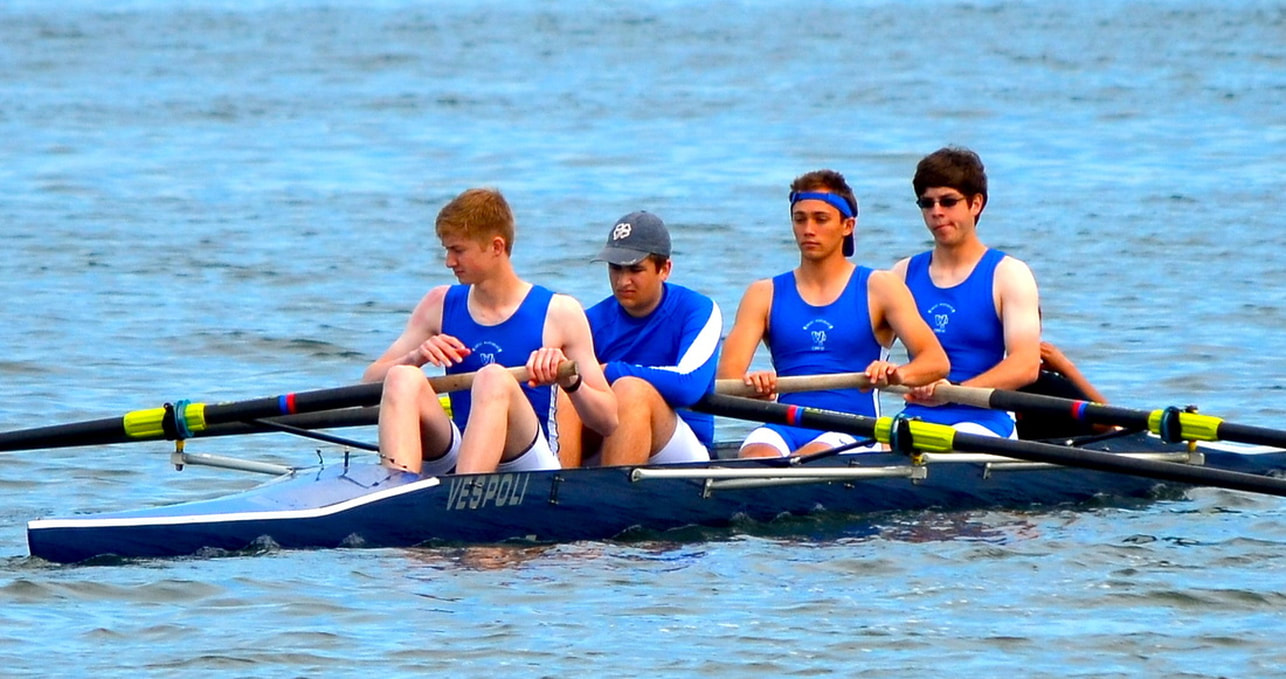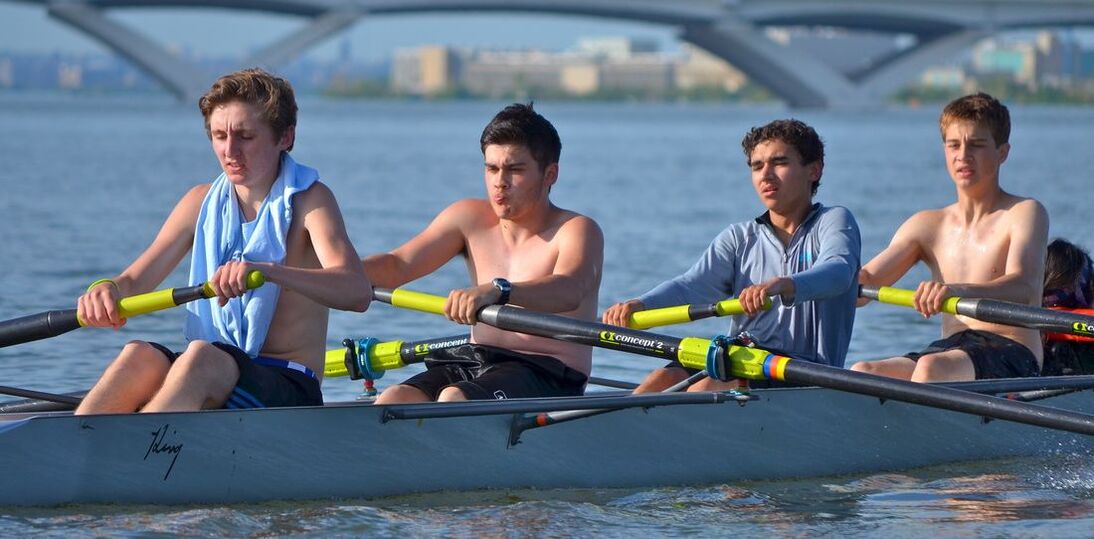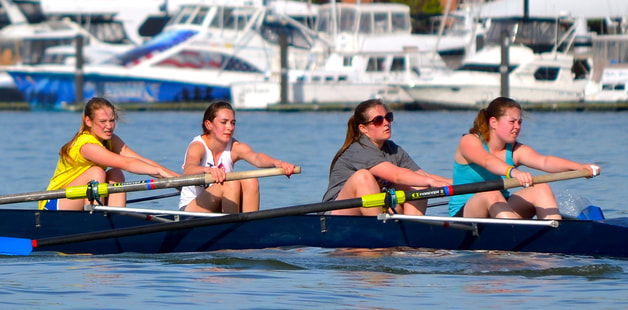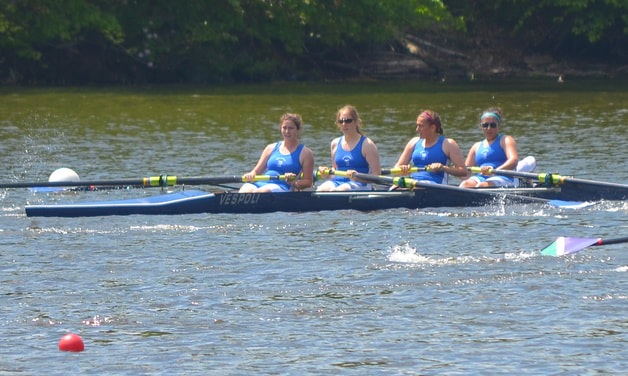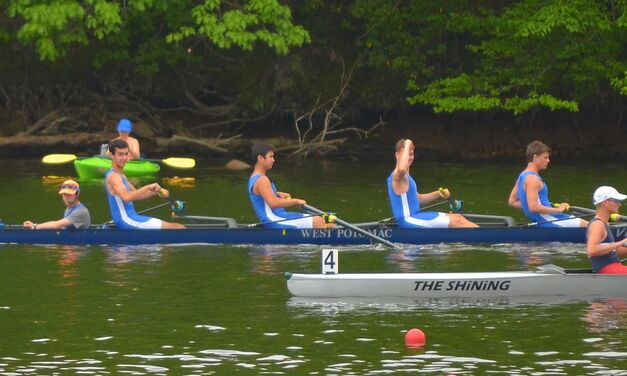Fundamentals
SCULLS & SWEEPS
There are two types of rowing, sculling and sweep. In sculling, each rower has two oars, each about 9.5 ft. long. Sculls can be singles (1X), doubles (2X), or quads (4X). In sweep rowing, each rower has only one oar, about 12 ft. long. Sweeps come in pairs (2-) and fours with (4+) or without coxswains (4-) and eights (8+) with coxswain. At UHS we will primarily sweep in pairs (2-), fours (4+) and eights (8+) with coxswain.
Please note: the + or – indicates whether a coxswain is present. An X signifies 2 oars, or sculling.
In both kinds of racing, rowers are able to take long powerful strokes with the oars because their seat moves while their feet are in shoes attached to a footboard about 2.5 ft. long. The design of a shell creates a dynamic combination of speed and strength. For example, an 8-oared shell is 60 ft. long, weighs less than 250 lbs., and can carry a crew weighing as much as 1,800 lbs.
There are two types of rowing, sculling and sweep. In sculling, each rower has two oars, each about 9.5 ft. long. Sculls can be singles (1X), doubles (2X), or quads (4X). In sweep rowing, each rower has only one oar, about 12 ft. long. Sweeps come in pairs (2-) and fours with (4+) or without coxswains (4-) and eights (8+) with coxswain. At UHS we will primarily sweep in pairs (2-), fours (4+) and eights (8+) with coxswain.
Please note: the + or – indicates whether a coxswain is present. An X signifies 2 oars, or sculling.
In both kinds of racing, rowers are able to take long powerful strokes with the oars because their seat moves while their feet are in shoes attached to a footboard about 2.5 ft. long. The design of a shell creates a dynamic combination of speed and strength. For example, an 8-oared shell is 60 ft. long, weighs less than 250 lbs., and can carry a crew weighing as much as 1,800 lbs.
OARS
Oars not only move the boat through the water but act as balancers to help “set,” or balance the boat. Each oar is mounted in a swivel oarlock, which is attached to a rigger.
Oars not only move the boat through the water but act as balancers to help “set,” or balance the boat. Each oar is mounted in a swivel oarlock, which is attached to a rigger.
BOAT POSITION
There are eight rowing positions in a racing shell.
Seats 1 and 2 are referred to as the bow pair. This pair “sets the boat” or balances the boat. Rowers in these positions must have a smooth and fluid technique.
Seats 3, 4, 5 and 6 are referred to as the power or engine seats. Rowers in these positions are usually “big and strong.”
Seats 7 and 8 are referred to as the stern pair. They set the stroke rate for each side of the boat. The 8 seat is one of the hardest to row since the rower must concentrate on both rowing and is mostly responsible for setting the rate of the boat.
It is important to remember that all three sections of the boat are equally important. A good winning boat consists of athletes rowing together as a team under the direction of their coxswain.
The coxswain is the eyes and ears of the boat. The coxswain’s role on the water is very involved as they must guide the boat to the starting line and get the boat lined up correctly. Once the race begins, he or she needs to be a good motivator because the coxswain is the only one who can talk to the rowers. Often described as the “brains in the boat,” the coxswain is responsible for:
There are eight rowing positions in a racing shell.
Seats 1 and 2 are referred to as the bow pair. This pair “sets the boat” or balances the boat. Rowers in these positions must have a smooth and fluid technique.
Seats 3, 4, 5 and 6 are referred to as the power or engine seats. Rowers in these positions are usually “big and strong.”
Seats 7 and 8 are referred to as the stern pair. They set the stroke rate for each side of the boat. The 8 seat is one of the hardest to row since the rower must concentrate on both rowing and is mostly responsible for setting the rate of the boat.
It is important to remember that all three sections of the boat are equally important. A good winning boat consists of athletes rowing together as a team under the direction of their coxswain.
The coxswain is the eyes and ears of the boat. The coxswain’s role on the water is very involved as they must guide the boat to the starting line and get the boat lined up correctly. Once the race begins, he or she needs to be a good motivator because the coxswain is the only one who can talk to the rowers. Often described as the “brains in the boat,” the coxswain is responsible for:
- Steering the boat by giving directions to the rowers and keeping the boat in the proper lane to avoid penalties;
- Watching the crew; spotting errors and making relevant observations. A coxswain must know rowing technique, so that if a correction is necessary, he or she will know what to do and who should do it;
- Telling the crew where they are in relation to the other boats and how much farther they have to go to win; and
- Executing the coach’s game plan, as the coach can’t be with the boat during the race.
THE ROWING MOTION
The whole body is involved in moving a shell through the water. Basically the stroke is made up of four parts: catch, drive, finish and recovery.
As the stroke begins, the rower is coiled forward on the sliding seat, with knees bent and arms outstretched. At the catch, s/he drops the blade vertically into the water. At the beginning of the drive, the body position doesn’t change—the legs do all the work. Then, as the upper body begins to uncoil, the arms begin their work, drawing the blades through the water. Continuing the drive, the rower moves his or her hands quickly into the body, which by this time is in a “layback” position. During the finish, the oar handle is moved down drawing the blade out of the water. At the same time, the rower feathers the oar, or turns the oar handle so that the blade changes from a vertical position to a horizontal one. This feathering cuts down wind resistance and avoids hitting the water. The oar remains out of the water as the rower begins recovery, moving his or her hands away from the body and past the knees. The body follows the hands and the sliding seat moves forward until, knees bent, the rower is ready for the next catch.
Hang in there! You're going to get this, we promise! After the first few weeks, it will all make sense . . . don't give up!
The whole body is involved in moving a shell through the water. Basically the stroke is made up of four parts: catch, drive, finish and recovery.
As the stroke begins, the rower is coiled forward on the sliding seat, with knees bent and arms outstretched. At the catch, s/he drops the blade vertically into the water. At the beginning of the drive, the body position doesn’t change—the legs do all the work. Then, as the upper body begins to uncoil, the arms begin their work, drawing the blades through the water. Continuing the drive, the rower moves his or her hands quickly into the body, which by this time is in a “layback” position. During the finish, the oar handle is moved down drawing the blade out of the water. At the same time, the rower feathers the oar, or turns the oar handle so that the blade changes from a vertical position to a horizontal one. This feathering cuts down wind resistance and avoids hitting the water. The oar remains out of the water as the rower begins recovery, moving his or her hands away from the body and past the knees. The body follows the hands and the sliding seat moves forward until, knees bent, the rower is ready for the next catch.
Hang in there! You're going to get this, we promise! After the first few weeks, it will all make sense . . . don't give up!
RACING
A competition in rowing is called a regatta.. In the fall the regattas are called head races and are 4000- 5000 meters long. Winners are determined by the best time in a race. In the spring races are 1500-2ooo meter sprints. The boats line up in lanes and race. This is very similar to high school running where the long distance races are in the fall (cross country) and the sprints are in the spring.
Crews are held stationary by stake boat holders at the start of the race until the referee gives the go command. Should a crew anticipate this command and cause a false start, the boats will be called back to the start. A crew assessed two false starts may be disqualified. Once the race has begun, only the referee, following behind in a motor launch, may stop the crews. The boats are to stay in their lanes. Crews that stray out of their lane will not necessarily be penalized as long as they do not interfere or impede any other competitors. Oars and bodies must move together as one.
Frequently the races are divided into flights—shells are grouped according to ability and size. For example, all Women’s Lightweight Varsity 8s will race against each other. The winning boat is the one whose bow (signified by a bow ball on the shell) crosses the finish line first between designated markers.. Under good weather conditions, an 8-oar men’s crew can row this distance in less than 5-6 minutes, often averaging speed 14 m.p.h.
PLUS!! Added BONUS!! IT'S GREAT FUN!
A competition in rowing is called a regatta.. In the fall the regattas are called head races and are 4000- 5000 meters long. Winners are determined by the best time in a race. In the spring races are 1500-2ooo meter sprints. The boats line up in lanes and race. This is very similar to high school running where the long distance races are in the fall (cross country) and the sprints are in the spring.
Crews are held stationary by stake boat holders at the start of the race until the referee gives the go command. Should a crew anticipate this command and cause a false start, the boats will be called back to the start. A crew assessed two false starts may be disqualified. Once the race has begun, only the referee, following behind in a motor launch, may stop the crews. The boats are to stay in their lanes. Crews that stray out of their lane will not necessarily be penalized as long as they do not interfere or impede any other competitors. Oars and bodies must move together as one.
Frequently the races are divided into flights—shells are grouped according to ability and size. For example, all Women’s Lightweight Varsity 8s will race against each other. The winning boat is the one whose bow (signified by a bow ball on the shell) crosses the finish line first between designated markers.. Under good weather conditions, an 8-oar men’s crew can row this distance in less than 5-6 minutes, often averaging speed 14 m.p.h.
PLUS!! Added BONUS!! IT'S GREAT FUN!
How to Look Like a Rowing EXPERT
- If you hear somebody say “heads up,” people carrying a shell are trying to get someplace with it and you are in the way.
- Single rowers are scullers — they row a scull, not a skull. Rowers who row an 8+ or 4+ “sweep,” but they are called rowers not sweepers!
- If you hear a rower say “I caught a crab”, he/she isn’t talking about marine life. If a blade enters the water at an improper angle, it can get caught under the surface. The oar handle drives into the stomach and has the potential to throw the rower out of the boat.
- Don’t call a crew a “crew team” — that’s tantamount to saying “team team.”
- Remember that coxswain is pronounced cox-n, the sw is silent.
